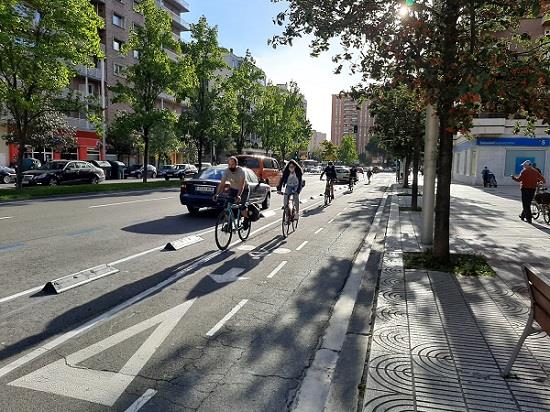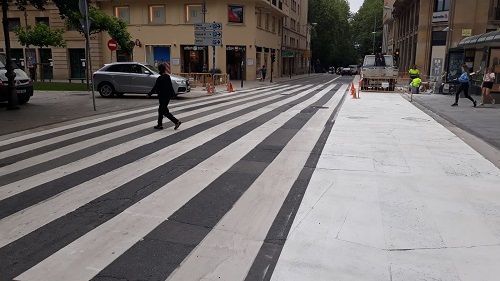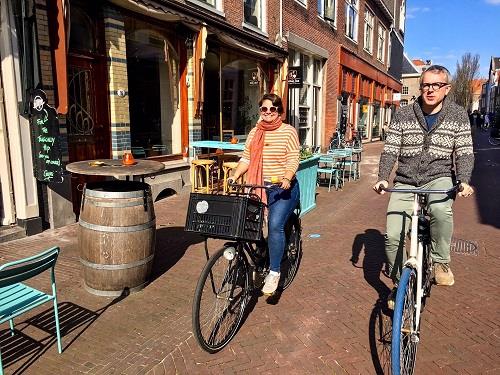Willingly or forced by circumstances, cities across Europe have slowly started to change their vision about urban mobility. “Towns built for people not for cars” is a concept acknowledged even before the coronavirus outbreak, due to the high level of pollution released by the heavy traffic in the big communities. Now, social distancing imposed by the sanitary crisis has led many municipalities to offer their citizens new travelling ways to avoid gatherings on public transport along with an excessive use of private cars. This has often meant the introduction of new cycle paths and 30 km/h zones to keep road traffic speeds down and boost so called soft mobility.
Turin, known as the Detroit of Italy because of its FIAT car industry (today FCA) founded in 1899, is one of the most polluted European cities. Surrounded by a wonderful belt of mountains that nevertheless traps emissions, it forcibly started to rethink its mobility fifteen years ago, reserving the historic areas of the centre for pedestrians and introducing increasingly restrictive measures to limit private cars. But in the last few years the city centre has been radically transformed.
Mayor Chiara Appendino says: “Turin already had a Biciplan [a ‘bike plan’ which aims to increase the share of bike travel to 15% by 2023, ed. note]. The Covid-19 emergency has accelerated this project. In a very short time we planned 95 km of new cycle paths. Moreover, we have introduced new solutions such as the ‘bike boxes’ – we are among the pioneers in Italy – which are spaces in front of crossroads regulated by traffic lights that allow bicycles and scooters to position themselves in front of the stopped cars, so they have priority in turning and don’t breathe in the exhaust gases.”

Chiara Appendino, mayor of Turin, Italy, riding a bike during the Covid-19 pandemic– Courtesy of Municipality of Turin
According to the Traffic Operations Centre of the Municipality of Turin, which is managed by the company 5T that monitored the five main cycle paths of the city, the flow of bikes increased by 6.9% in August, compared to the same period in 2019.
However, there is also the other side of the coin. This traffic revolution has led to an increase in road accidents with pedestrians and cyclists injured. And motorists have protested as they are concerned about traffic jams due to roads being narrowed to make way for cycle paths.
Appendino affirms that the authorities are aware that people need to use cars in many situations (elderly people or with disabilities, but also some workers). But she believes that alternatives to motorized transport should be created: “There is a need of a cultural change, which implies an increased awareness of our choices and our actions. Why should a roadway be dedicated 100% to cars, instead of allocating some room for those who choose more sustainable vehicles?” She states that roads cannot be enlarged to meet all the needs because of their structural issues: “Traffic is like water, it goes wherever space is. And if there is more space, there will be more traffic. Our cities are a wonderful heritage of history and were not born to fit cars into them”.
In Spain, one of the first cities to fully embrace the idea of safer and sustainable transit system is Pamplona, a pioneer in electric mobility with a dedicated plan approved ten years ago. Today it is one of the “lighthouse” smart cities of the EU project Stardust, which brings together advanced European urban areas ready to test innovative solutions in ICT, mobility, energy efficient buildings and citizen engagement. Within this project, the Public Transport Authority (member of the Stardust consortium together with the Pamplona Municipality and other local stakeholders) achieved in 2019 an electric bus line that – at the time of its commissioning – was the largest 100% electric bus line in Spain. During the first nine months of its operation, the environment authorities noticed a reduction by 191 tonnes of CO2 emissions.

Pamplona, Spain: new bike lines built in only two months during the Covid-19 pandemic – Courtesy of Municipality of Pamplona
In line with its commitment to become a greener city, Pamplona supports people in acquiring e-vehicles, by providing fast charging points, free parking and tax breaks. Maribel Gómez Jiménez, head of Mobility unit, which is included in the area of Strategic Projects, Mobility and Sustainability of the municipality, says: “There are six charging points so far and we want to extend the network to 30, in less than one year. The use of the electric cars has increased in an exponential way lately, from 80 cars in 2018 to around 250 now.”
During the current sanitary crisis, the Public Transport Authority has adapted the bus fleet to reduce the risk of contracting the coronavirus: the vehicles are running at half capacity with the number of passengers regulated through an intelligent entry and exit system. Like in Turin, the pandemic has accelerated Pamplona’s plans to promote clean mobility.
Two important axes of the city, near the Arga River, have been extended for the use of the pedestrians and cyclers. “The intervention has been done to provide more space and distance for people and to improve the quality of urban life”. Some painting works have been undertaken, together with the installation of urban furniture and flower boxes.

Pamplona, Spain: during the Covid-19 pandemic sidewalks have been widened and buses’ canopies in the main boulevard moved, to allow a fluent pedestrians flow – Courtesy of Municipality of Pamplona
In the city centre, other pavements have been widened and buses’ canopies from the main boulevard moved to facilitate the flow of fluent pedestrians. In addition, parts of the two main roads were turned into bike lanes in less than three months, explains Gómez. She thinks that narrowing the car routes has not been too disruptive to car drivers so far: “It's too earlier to see the effects but I think people have become more tolerant during the sanitary crisis. What is sure, because we can see it, is that cyclists are using the new lanes and apparently their number is growing. Likewise, pedestrians are conquering the new spaces and car drivers are adapting to the new context,” adds Gómez.
To help cyclists, the municipality has built six modular parks, provided with charging systems for electrical bikes. Those who want to leave their bike in one of these secured “garages” register through a website or via an app downloaded on their mobile phone. The fee is affordable for all, explains Gómez: “It costs €2 per month and users can leave their bikes for up to 48 hours in the same garage. This limit is designed to ensure rotation. A charge of €0.5 per hour for longer stays applies. However, during the coronavirus emergency, this extra charge has been waivered.”

Pamplona, Spain: cycle parking for bicycles, with charging systems for the electrical bikes – Courtesy of Municipality of Pamplona
“We made a report about the evolution of air quality in the city: during the lockdown it improved a lot since people were forced to stay at home. From 14 March to 21 June, we saw a 61% decrease in nitrogen oxides, 56% in nitrogen dioxide and 70% in nitrogen monoxide compared to the levels recorded from 26 February to 13 March. But the interesting thing is that in the following period, from 22 June to 13 July, these figures didn’t go up (57% for nitrogen oxides, 62% less for nitrogen dioxide and 47% less for nitrogen monoxide).Therefore there still were fewer cars in our streets. Moreover, the average value of nitrogen dioxide during quarantine was 10.16 µg /m³ (very close to the value considered to be of very good air quality, 10 µg/m³); today, with schools opened, it is 16 µg /m³, while the average in 2019 was 23 µg/m³.”
The bicycle should not be seen as the enemy of the car, but simply as an alternative. Canadian architectural designer Chris Bruntlett, co-founder together with his wife Melissa Bruntlett of Modacity, a creative agency which promote healthier forms of mobility, states: “A great cycling city can also mean a great driving city”. He gave as an example the Netherlands, a country with an extended cycling infrastructure that has one of the least traffic congestion in the world, due to the mobility mix. “Not everybody will choose a bicycle, and those who want or need to drive have plenty of road space”.

Delft, Netherlands: Melissa and Chris Bruntlett – By Mitchell Reardon
The Bruntletts’ stories of emerging bike cultures from around the world have been featured in many newspapers. Melissa has emphasized the need of alternatives in mobility: “People should be provided with options, so that they could combine the bike with the tram, or they could do biking and walking, driving etc. Getting rid of the cars could become more convenient for them, more attractive and, in most cases, faster.”
She mentions the cities in North America, where people had no other choice than the car, until better options were created. “Even Vancouver, Canada, which is a lovely, green and wonderful space, is still very heavily dominated by cars. But the city hall has started to build up a cycling network, created a safer space and linked the networks to the public transportation and to the recreation areas,” she stated. On the North American continent, other important cities which are taking significant actions towards supporting both cycling and driving are Austin (Texas, USA) and Calgary (Alberta, Canada). Investment in cycling infrastructure can cost cities less than a potential climate crisis, caused by the pollution. The time during and after the lockdown, when people are continuing to work from home, could be a unique opportunity for a change.
The Netherlands started to build their giant cycling infrastructure at the beginning of the Seventies, when Arab oil exporters imposed an embargo on countries supporting Israel in the Yom Kippur war and motorists saw skyrocketing fuel prices. At the same time, people protested across the country against an unbearable increase in road-accident deaths. Considering that the Dutch mobility revolution followed a crisis, both economic and social, the current sanitary crisis may reshape the mobility model in other cities worldwide.
youris.com provides its content to all media free of charge. We would appreciate if you could acknowledge youris.com as the source of the content.